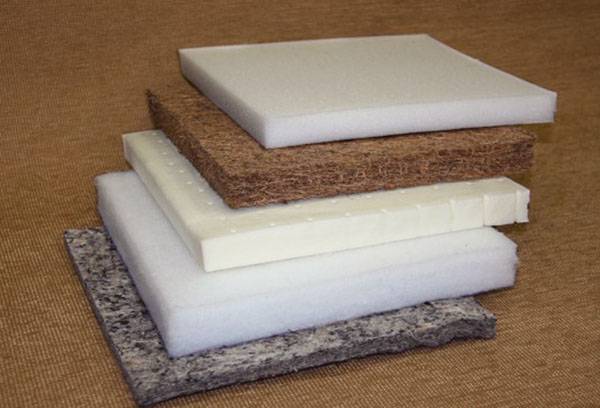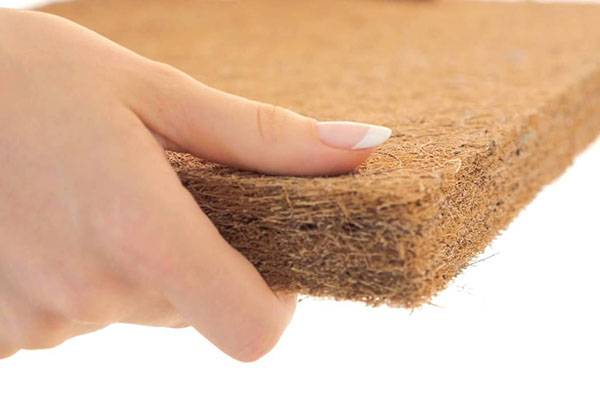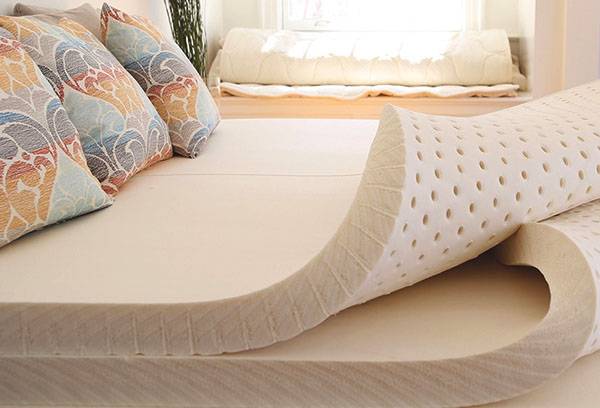Which mattress filler is best for a healthy sleep?
Healthy sleep and good rest cannot be achieved without a comfortable mattress made of durable and safe materials. If earlier fillers for mattresses were mainly represented by foam rubber and batting, today these products consist of a combination of the latest materials. Mattresses are filled with familiar natural wool and exotic fiber obtained after processing a coconut tree; latex extracted from hevea juice and polyester hollcon. In order not to get confused by the variety of products and choose a really convenient and suitable thing, you should familiarize yourself with the features of fillers for mattresses before going to the store.
What are sleeping mattresses
All mattresses are divided into two categories: with and without a spring device. It is not possible to clearly determine which design is better. Some people like to experience a slight wiggle during sleep, which provides a spring device. Others prefer to lie on a flat, hard surface and cannot stand even the slightest hesitation.
Spring blocks, in turn, are divided according to the method of fastening individual elements into two types.
- Addicted. In the device, all the springs are rigidly fastened together so that the pressure on one part sets in motion several neighboring ones. Mattresses with a dependent Bonnel spring block are not able to provide the proper supporting effect. However, the buyer is usually seduced by the low cost of the product, which is quite suitable for replacing an old worn mattress. In addition, such bedding is often used to equip hotels and hospitals.
- Independent. In designs with independent springs, each part is placed in a separate fabric cover. As a result, the load is distributed evenly over the entire surface, the hammock effect is completely absent, the mattress perfectly supports the body and does not make noise when a person moves.
A wide group of mattresses are products that do not contain metal structures. Various natural and artificial materials act as a filler here. They can be used both separately and in combination with each other.
Natural Fillers
At present, when modern technologies make it possible to obtain textile materials by combining chemicals, many people are more and more drawn to nature and try to surround themselves with natural things. A natural-filled mattress is able to provide a high level of comfort. It perfectly passes air, so it is not hot to sleep in the summer and not cold in the winter. Materials such as coconut coir or bamboo fiber can not only provide bactericidal protection, but also massage the body. What natural materials are most often used as filler for mattresses, the author of purityis.decorexpro.com/en/ understood.
- Felt
This environmentally friendly material is made from sheep’s wool or cotton in the form of panels of various thicknesses. Felt is used in spring mattresses as a layer that provides proper rigidity and neutralizes the feeling of springs. In addition, this dense elastic material is used as a layer between different soft fillers.
- Latex
Latex filler is made from Hevea juice by heat treatment and foaming.The result is a lightweight porous material with excellent breathability, thermal conductivity and resistance to getting wet.
Thanks to these properties, latex has become one of the most common fillers for mattresses. The material withstands heavy loads, quickly restores shape after pressure, has an orthopedic and anatomical effect. Natural latex does not cause allergic reactions and is completely safe for human health. The only negative is the high cost.
- Batting
Everyone knows the batting, which is usually filled with cheap mattresses in summer camps, kindergartens or hospitals. It consists of pure cotton, provides good air exchange, does not cause allergies.
Cotton filler has a significant drawback - it quickly cakes, straying into lumps. Recently, it began to be used as a layer between other materials and for the manufacture of bilateral winter / summer mattresses.
- Wool fiber
The wool of a sheep or a camel serves as a good filler for mattresses. Hygroscopic and hygienic fibers perfectly absorb water, creating a special microclimate in bed. Wool does not accumulate static electricity, so the mattress does not sparkle in the dark and does not irritate the nervous system.
Wool fibers collected from sheep are coated with lanolin, which provides antibacterial properties of the filler, reduces joint pain, and relieves fatigue. So far, it has not been possible to create a synthetic material similar in properties to natural wool.
- Coconut fiber
Environmentally friendly filler is made from coconut fiber and has unique characteristics. He is not afraid of any humidity, since the material is not subject to decay. A coconut coir mattress does not cause allergies; for many years it remains firm and elastic. The thicker the filler layer, the greater the stiffness of the product.
- Sea grass
The seaweed filler is made as follows. Sea grass is well dried, weaved into tight pigtails and attached to jute fabric. Natural material extracted from the bottom of the ocean does not decay and is not electrified, and the gaps between the particles of grass provide a natural circulation of air.
Seaweed contains a large amount of iodine, which after drying the grass does not disappear anywhere, so this filler also has the effect of aromatherapy.
Artificial Materials
Millions of leading companies today are working on the creation of new synthetic materials that surpass natural analogues in their characteristics. Mattress manufacturers are particularly interested in artificial fillers such as struttofiber, holkon, polyurethane foam and spunbond.
- Hollcon
Hollcon is a synthetic filler made from polyester fiber. The finest threads are twisted into small elastic springs, which are then connected to each other by heat treatment. This stuffing does not cake, is well ventilated, does not absorb odors. Mattresses with holklon are not deformed, retaining their original shape for a long time.
Important!
No harmful insects, in particular dust mites, can live in the hollcon. Therefore, mattresses with such a synthetic filler are recommended for people suffering from allergies and bronchial asthma.
- Polyurethane foam
Polyurethane foam (PUF) is one of the most popular synthetic materials used to fill mattresses. Using it, you can create surfaces with an anatomical effect, since the foam material with high accuracy repeats all the bends of the body and provides reliable support during sleep. The disadvantage of this filler is a short service life, which fully compensates for the low cost of the products.
- Stratofiber
A stratofiber made of polyester fiber differs from other synthetic fillers in that the threads are arranged vertically. Due to this structure of the material, the mattress has good orthopedic properties. Often, struttofiber is used as a frame for softer materials or in combination with other fillers.
- Spanbond
Spanbond is a lightweight, strong, durable and cheap filler made from 100% polypropylene. It lends itself perfectly to cutting, allows air to pass through, and prevents ignition; therefore, expensive materials are often replaced with spanbond. It is especially valuable as a gasket between fillers, as it helps to distribute the load and gives strength to the mattress.
By creating unique models, mattress manufacturers strive to draw the attention of customers to their products. Spring-filled mattresses differ in their degree of rigidity; in products without metal structures, the number of layers and the combination of materials change.
A variety of products makes it easy to choose a model depending on the tastes and preferences of the buyer. Hard bed lovers will find a coconut coir mattress. Those who prefer to relax on a soft bed, it is better to buy bedding made of latex or polyurethane.


